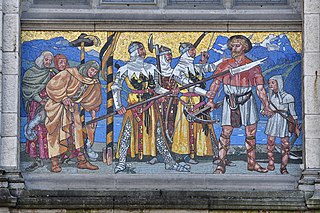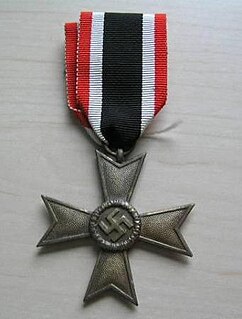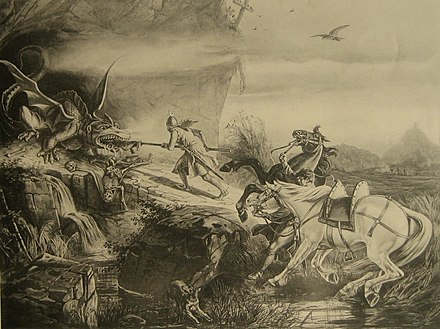
The Codex Manesse, Manesse Codex, or Große Heidelberger Liederhandschrift is a Liederhandschrift, the single most comprehensive source of Middle High German Minnesang poetry, written and illustrated between c. 1304 when the main part was completed, and c. 1340 with the addenda.

Stans is the capital of the canton of Nidwalden (Nidwald) in Switzerland.

The Livonian Order was an autonomous branch of the Teutonic Order, formed in 1237. From 1435 to 1561 it was a member of the Livonian Confederation.

William Tell is a folk hero of Switzerland. According to the legend, Tell was an expert marksman with the crossbow who assassinated Albrecht Gessler, a tyrannical reeve of the Austrian dukes of the House of Habsburg positioned in Altdorf, in the canton of Uri. Tell's defiance and tyrannicide encouraged the population to open rebellion and a pact against the foreign rulers with neighbouring Schwyz and Unterwalden, marking the foundation of the Swiss Confederacy.

The Battle of Sempach was fought on 9 July 1386, between Leopold III, Duke of Austria and the Old Swiss Confederacy. The battle was a decisive Swiss victory in which Duke Leopold and numerous Austrian nobles died. The victory helped turn the loosely allied Swiss Confederation into a more unified nation and is seen as a turning point in the growth of Switzerland.

Arnold von Winkelried or Arnold Winkelried is a legendary hero of Swiss history. According to 16th century Swiss historiography, Winkelried's sacrifice brought about the victory of the Old Swiss Confederacy in the Battle of Sempach (1386) against the army of the Habsburg Duke Leopold III of Austria.
Winkelried was a family of Unterwalden, recorded as members of the lower nobility during the second half of the 13th century and as commoners during the 14th to early 16th centuries. The name is mostly associated with Arnold von Winkelried, the hero of the Battle of Sempach (1386) in Swiss historiography. Because of the importance of Arnold Winkelried in 19th-century Swiss nationalism, much research has gone into the genealogy of this family.

The War Merit Cross was a decoration of Germany during the Second World War, which could be awarded to military personnel and civilians alike. By the end of the war it was issued in four degrees; and had a related civil decoration. It was reissued in 1957 by the Bundeswehr in a de-Nazified version for veterans.

AegidiusTschudi was a Swiss statesman and historian, an eminent member of the Tschudi family of Glarus, Switzerland. His best known work is the Chronicon Helveticum, a history of the early Swiss Confederation.

The Grand Master is the holder of the supreme office of the Teutonic Order. It is equivalent to the grand master of other military orders and the superior general in non-military Roman Catholic religious orders. Hochmeister, literally "high master", is only used in reference to the Teutonic Order, as Großmeister is used in German to refer to the leaders of other orders of knighthood.

The Rütlischwur is the legendary oath taken at the foundation of the Old Swiss Confederacy by the representatives of the three founding cantons, Uri, Schwyz and Unterwalden, traditionally dated to 1307. It is named for the site of the oath-taking, the Rütli, a meadow above Lake Uri near Seelisberg. Recorded in Swiss historiography from the 15th century, the oath is notably featured in the play William Tell by Friedrich Schiller (1804).
von Glarus is a family of lower nobility (knights) from Glarus in Switzerland.

A dragonslayer is a person or being that slays dragons. Dragonslayers and the creatures they hunt have been popular in traditional stories from around the world: they are a type of story classified as type 300 in the Aarne–Thompson classification system. They continue to be popular in modern books, films, video-games and other entertainments. Dragonslayer-themed stories are also sometimes seen as having a chaoskampf theme - in which a heroic figure struggles against a monster that epitomises chaos.

Rudolf von Erlach was a knight and commander of the Swiss Confederation forces at the Battle of Laupen.

The Austrian Imperial Order of the Iron Crown was one of the highest orders of merit of Austria and Austria-Hungary until 1918. It was re-established in 1815 by Emperor Franz I of Austria. The original Order of the Iron Crown had previously been an order of the Napoleonic Kingdom of Italy.
Hermann von Liebenau was a Swiss historian.
Mueterschwanderberg is a ridge forming the southern shore of Alpnachersee, just northwest of Stanserhorn and west of the village of Ennetmoos, Nidwalden, Switzerland. Its peak is at an elevation of 860 m. The peak is known as Drachenflue (Drachenfluh), with the Drachenloch cave nearby, named for the dragon which according to legend was slain here by Heinrich von Winkelried.
In legend and in the early historiography of Switzerland there is an account of a migration of a population of Swedes and Frisians settling in the Swiss Alps, specifically in Schwyz and in Hasli (Schwedensage).

The House of Rapperswil respectively Counts of Rapperswil ruled the upper Zürichsee and Seedamm region around Rapperswil and parts of, as of today, Swiss cantons of St. Gallen, Glarus, Zürich and Graubünden when their influence was most extensive around the 1200s until the 1290s. They acted also as Vogt of the most influential Einsiedeln Abbey in the 12th and 13th century, and at least three abbots of Einsiedeln were members of Rapperswil family.
Petermann of Gundoldingen was Schultheiss of Lucerne and participated in the Battle of Sempach.















